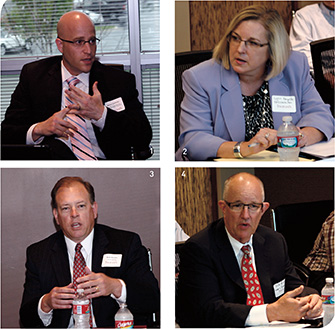
1. Brian Leitner’s observation about the need to retain clients across generations touched off a lengthy review of demographic trends. | 2. Despite the onset of Baby Boomer retrirements, Lynn Mayabb said, many clients remain in the wealth accumulation phase. | 3. Brett Broyles said sound investing for the long term relied on adhering to core principals, regardless of market swings. | 4. Bob Rippy mentioned clients are better served with a focus on total return, rather than on high yield alone.
Expectations
Given a five-year bull market with very few pullbacks, Leitner asked his peers whether clients were evaluating their services differently than they had in the past.
Mark Eveans, president and chief investment officer of Meritage Portfolio Management, believes that the focus of the marketplace in terms of marginal dollars is headed towards the RIA (registered investment adviser) space, as now defined. “As an investment answer,” said Eveans, “we’re looking at the broad market, where can we make the biggest difference.”
“There are a lot of things that have happened over the last six years that have made it apparent that the securities industry doesn’t necessarily have the average investor’s well-being at heart,” said Ken Eaton, a principal at Stepp & Rothwell. He cited the bank failures of six years ago, the Bernie Madoff scandal, the much-discussed high frequency trading issue, and the phenomenon of Goldman Sachs trading against its own clients.
“All these investors are now wondering how they can get advice from somebody who has their best interests at heart,” said Eaton. “They are looking for objective advice, and of course, the best way to give someone objective advice is to make sure that there aren’t any other incentives in the way.”
“I think Ken hit the nail on the head,” said Brett Broyles. “Clients are much more cognizant that there could be conflicts of interest, and they are proactively looking for a firm that is unbiased in its approach.”
KC Mathews, chief investment officer at UMB, expressed concern about how this next generation, the recipient of that wealth transfer, will value a wealth adviser. “This is a relationship business, but that definition of a relationship might be very different for one who might be 70 years old than . . . that next generation.”
“We all know the statistics,” said Leitner. When the parents die, about 85 percent of that wealth “goes out the door.” Mariner has built a trust company to help capture some of those assets when a client passes.
Yield
Given the low-interest-rate environment, Brian Leitner asked his colleagues where they were sending their clients to find yield.
“I was just going to say buy energy,” said Kevin Birzer, senior managing director and co-founder of Tortoise Capital Advisors. Birzer acknowledged that all his firm does is energy. That much said, the recommendation has a logic. As Birzer put it, “The North American energy revolution is real” and has the potential to expand for a decade or more.
Lynn Mayabb, managing director of BKD Wealth Advisors, recommended looking at the total portfolio return. “Realistically,” said Mayabb, “a lot of clients aren’t taking money out of portfolios. They don’t have that need yet and are still in the accumulation phase.”
“We try to help our clients replace the thought of high yield with total return,” affirmed Bob Rippy, senior vice-president of Robert W. Baird & Co. Rippy admitted that was a hard sell to the more traditional clients who have favored high-yield scenarios.
Eleven years ago, as Mark Eveans explained, Meritage Portfolio Management started a concept called Yield Focus, based on deep undervaluation of dividend flow. The strategy employs every publicly traded, liquid, direct payment security available: development companies, REITs, convertible preferred stocks, even straight equity preferred, where they yield enough to give a decent return. “This strategy searches the globe for all of those things,” said Eveans. “It’s a relentless, broad search for yield.”